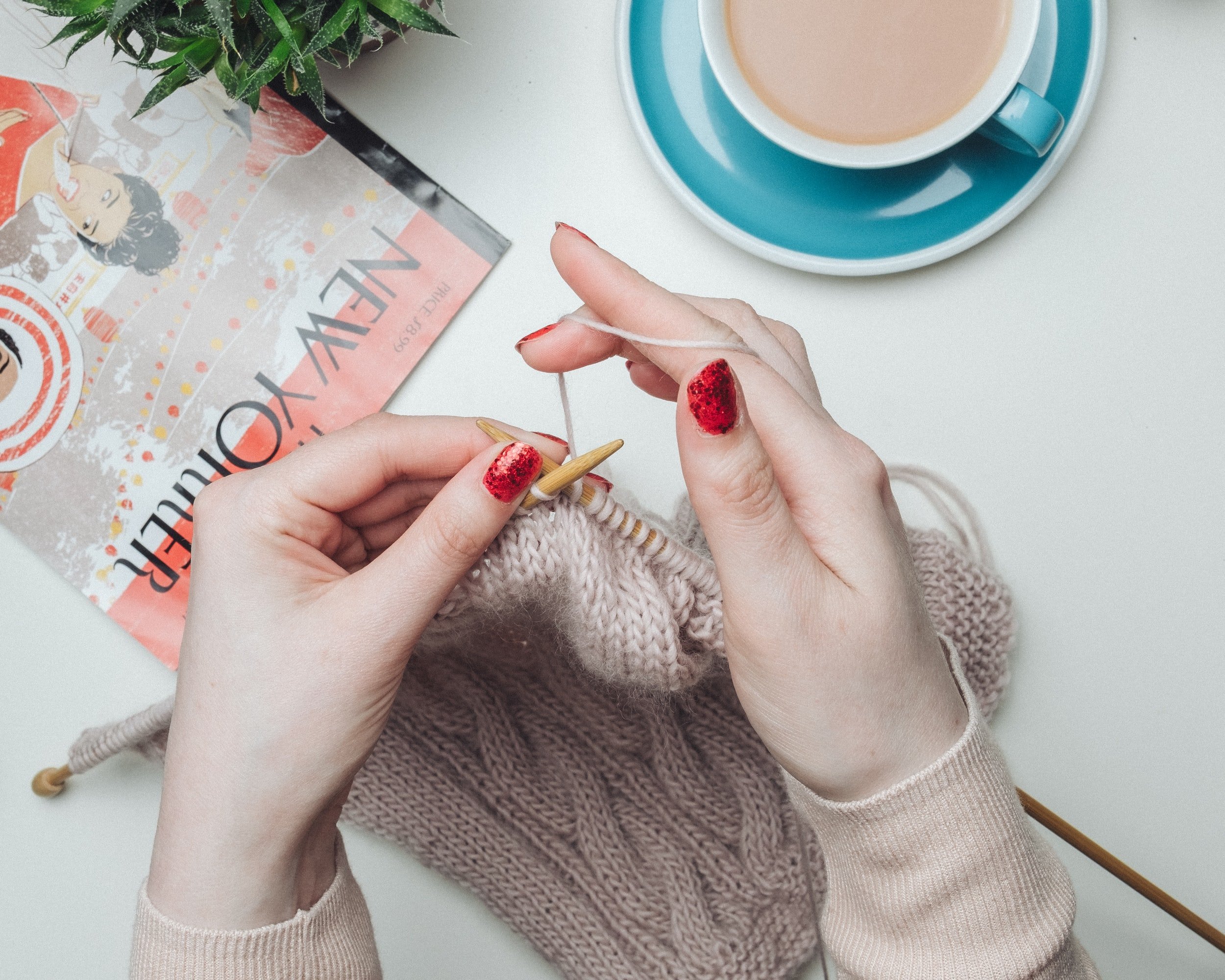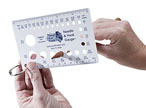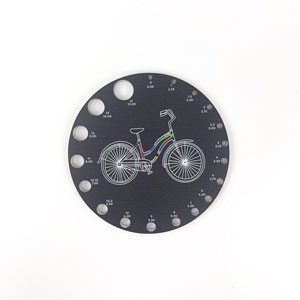What is gauge in knitting?
Gauge in knitting is simply the size of each stitch and the space between stitches. It is measured in stitches (horizontal measurement) and rows (vertical measurement). Since each stitch is usually pretty small, gauge is measured in stitches or rows per inch (2.54 cm), or 4 inches (10 cm). The smaller number of stitches per inch, the larger the stitches. Example: 4 stitches per inch will be larger stitches than 20 stitches per inch. The larger stitches are referred to as a larger gauge.
What influences knitting gauge?
There are many factors which contribute to the gauge of a knitted item: Yarn size, twist and content, needle size, type, material, and the stitch chosen all contribute to gauge, but also each knitter has his or her own tension.
Let’s break down a few factors which influence gauge in your knitting.
Yarn size
Yarns come in many sizes, from the tiniest, most delicate lace weight yarns, all the way up to yarns that resemble ropes. For many years, there wasn’t much of a system to classify yarn size. Knitters would refer to “4-ply”, meaning 4 strands of yarn, twisted together. This is still common in many countries. But thankfully for new knitters, the Craft Yarn Council developed a classification system to help fiber artists categorize and learn about different yarn sizes. You can view their standards chart here.
As you can imagine, yarn size can make a huge difference in gauge (since gauge literally means the size of the stitch!). Typically, the bigger the yarn, the smaller the gauge, simply because the same number of stitches won’t fit in that same inch. But this isn’t always true. For example, many lace patterns use the tiniest yarn on large needles to achieve large, loose stitches.
Yarn Twist
I’m not going to spend much time on twist here, because twist is a huge topic. Those who enjoy spinning yarn study twist and have written books on it! For our purposes, we’ll go super simple: If a yarn has a tighter twist, it will typically knit at a smaller size or gauge. Again, this isn’t always the case, because of all the other factors which influence gauge.
Look closely to determine how tightly your yarn is twisted
Yarn Content
Even if two yarns are the same weight (yarn size), they could be made of very different materials. Yarns can be made of all-natural, protein-based materials, like wool, alpaca, goat hair, etc. Yarns can be made of all-natural, plant-based materials, like cotton, linen, and bamboo. Yarns can be made of man-made materials like acrylic and nylon. Most yarns are actually a blend of multiple materials. These materials are chosen by the manufacturer or spinner because they each have different qualities. For example, nylon is often added to wool for sock yarn because it produces a much stronger, long-lasting sock. But these materials each behave differently in the yarn, causing the size of the stitches to change. Some really fluffy materials, like mohair can look really small, but the tiny fluffy fibers can fill in the gaps between stitches, changing the gauge.
Needle Size
Knitting needles come in lots of shapes and sizes. At their most basic, needles are just two sticks which we use to manipulate our yarn. I’m sure the first knitting needles were just small tree branches from the knitter’s back yard. But needles have come a long way.
There are two main systems for classifying needle sizes. Most of the world uses the metric system. But the US has its own system of classification. So in most patterns by knitwear designers from the States, the needle size recommended will be listed US needle size first, with metric needle size (the actual measurement) listed next, in millimeters.
Typically, increasing the needle size will create larger stitches. But this is only always true when it’s the same knitter, using the same yarn. As we’ll see later, the knitter is a vital factor in gauge.
Needle Type
Needles come in 3 main types, but there are many, many variations on these types. Needles can be “straight”, which simply means they have some sort of stopper on the end that keeps the stitches from falling off. Needles can be “double points”, or “dpns” and just as the name suggests, they have a point on each end, which allows the knitter to knit from either end. More recently, “circular” needles have been developed. Circular needles are my favorite. They are simply two needles connected by a cord in the middle. These cords are made of different materials, depending on the manufacturer. I love these needles, because I can work in a seamless circle while knitting, or use them to work back and forth for a flat piece. And I’m much less likely to lose a needle when I drop one!
What’s important about needle type is how the knitter’s hands interact with the different needle types. After lots of knitting, I know that my gauge is tighter when I knit on dpns than on circulars. So, I know that if I’m knitting a sweater and want to change to double pointed needles on the sleeves, I have to go up at least one needle size. Each knitter is different. You have to learn how your hands interact with each of the different types of needle.
Needle Materials
Needles also come in many different materials. For our purposes, I’d like to break them down into 3 basic categories: Wooden, Metal & Plastic. Each of these materials has benefits and drawbacks, but that’s for a different post!
Metallic needles tend to allow the yarn to slip off quickly, making them faster to knit with. But this slipperiness changes how the knitter’s hands interact with the needles and the yarn and will affect gauge.
Wooden needles, however, “grip” the yarn, ever-so-slightly, making it just a fraction more difficult for the yarn to slip off the needle. This fraction can impact your gauge, typically making the stitches smaller, but you have to learn this for YOUR hands, YOUR needles, and YOUR yarn.
Honestly, I don’t know how plastic needles affect my gauge, because I don’t really like the way plastic needles feel in my hands, so I don’t use them. But you do you! Make your hands happy!
Knitting Stitches
Our basic stitches for knitting consist of the knit stitch and the purl stitch. These stitches are just mirror images of each other. But the way the hands produce each of these stitches is totally different. They require different movements of the fingers, so quite often, the purl stitches are at a different gauge than the knit stitches. If this is pronounced, it will show up in our garter stitch (knitting in both directions on a flat piece) as a phenomenon we call “rowing out”. If you’re “rowing out”, your purl row will be noticeably different than your knit row. The different styles of knitting and ways of tensioning can affect whether or not you see tension differences in your rows.
But there are many, many stitch patterns which are created, using these basic knit and purl stitches. If you’re ready to move on to an interesting stitch pattern, check out a new pattern or even find a stitch dictionary. There are many out there to explore.
Different stitch patterns can greatly affect your knitting gauge! For example, cable stitches pull the work tight, as they cross over one another. This can create a much tighter gauge, which could even prevent your finished object from fitting over your head! Ribbing (the alternating of knits and purls) also pulls the fabric in. The stretchiness created by ribbing makes it perfect for collars and cuffs. But if you use ribbing in the body of the garment, you have to take into account how it will affect the gauge of the overall piece.
The knitter’s hands
To me, the single most important factor in gauge may be the knitter’s hands. We all learn to knit in different ways. I’m quite passionate that there is no “wrong way” to knit! Some of us carry the working yarn in the left hand, some in the right. Some of us tension our yarn by wrapping it around a finger or two. Other knitters may wrap it around their necks, or even just drop the yarn to lie loose. These different styles greatly influence the finished size of the stitches, by the tension exerted on the yarn.
The Knitter’s hands make a HUGE difference in the gauge!
But there’s also the knitter, herself (or his self). Some knitters are just “born” tighter or looser knitters. But our gauge can change over time. For example, when I first learned to knit, I constantly felt like I was going to drop my yarn or needles, so my stitches were super tight. Now, as a seasoned knitter, I’m no longer afraid. This confidence allows me to knit at a more natural gauge for me.
Also, our moods can change our gauge. If you’re angry while you’re knitting, your gauge will be tighter than if you’re relaxed and laughing with your friends!
As you can see, knitting gauge can be a complicated topic. Many knitters are intimidated by the mere mention of “gauge” and so they simply avoid it, resulting in finished objects that don’t fit or look good. This is a huge waste of yarn and time and is very frustrating! In my next post, I’ll dive into how to measure your stitch gauge, so you can create finished objects that actually fit your intended wearer!




